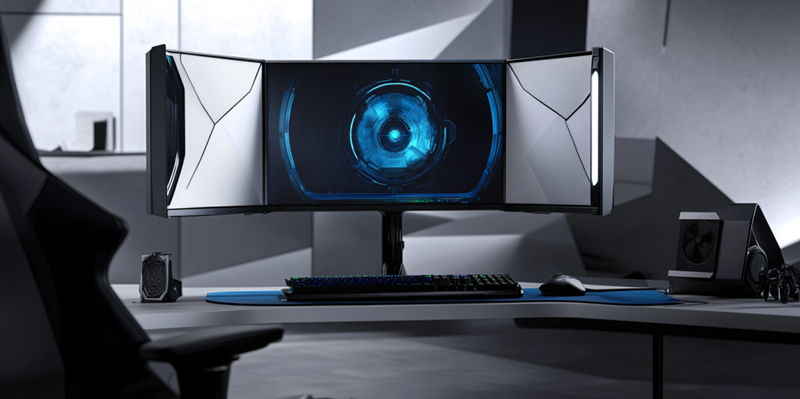ASRock, renowned for its motherboard and PC hardware production, has made a significant stride in the gaming monitor market with the announcement of six new high-spec monitors under the Phantom Gaming series. The latest additions are designed to cater to a diverse range of gamer preferences by offering a variety of screen sizes, resolutions, and refresh rates. This move signifies ASRock’s commitment to enhancing the gaming experience through state-of-the-art technology and versatile options that meet the needs of both casual and competitive gamers.
By introducing models that range from 24.5 inches to 34 inches, ASRock has ensured that its new monitors will fit a broad spectrum of gaming setups and user preferences. Additionally, the emphasis on high performance is evident across the board, with features such as high refresh rates, quick response times, and vivid color gamuts being a hallmark of the new releases. With the addition of these six models, the ASRock Phantom Gaming series now boasts a total of 16 distinct monitors, each designed to deliver a top-notch gaming experience.
Diverse Screen Sizes and Curved Panels
The Phantom Gaming series showcases a mix of curved and flat panel designs, ensuring that users can find a monitor that complements their gaming setup. Among the new models, the PG34QRT3A and PG34QRT2B stand out with their 34-inch screens and 1500R curvature, which provides an immersive viewing experience ideal for gamers seeking a more enveloping field of vision. These models feature a VA panel type, offering deep blacks and high contrast ratios, which enhance the visual depth of games. Additionally, the 180Hz refresh rate and 1ms Moving Picture Response Time (MPRT) ensure that fast-paced action sequences are rendered smoothly, minimizing motion blur that could disrupt the gaming experience.
Notably, the PG34QRT3A includes a unique PG Mini-OLED display integrated into the monitor stand. This feature allows for personalized displays, adding a layer of customization that sets it apart from other models in the lineup. While the PG34QRT2B shares many specifications with the PG34QRT3A, including the curved panel and high refresh rate, it lacks the mini-OLED display, making it a slightly more streamlined option. Both models are designed to deliver an immersive and visually stunning gaming experience, making them ideal choices for gamers who prioritize screen size and visual quality.
Focus on Refresh Rates and Response Times
For gamers keen on performance, the series introduces the PG27FRS1A, which offers a blazing 280Hz refresh rate on a 27-inch screen. This model is perfect for competitive gaming, as it ensures that every frame is rendered with minimal delay, giving players a crucial edge in fast-paced scenarios. The high-speed panel type and rapid response time guarantee that ghosting and motion artifacts are drastically reduced, contributing to a smoother and more responsive gaming experience. This level of performance is particularly beneficial for eSports athletes and gamers who participate in competitive gaming environments, where split-second decisions and visual clarity can make all the difference.
In addition to the PG27FRS1A, the PG27QRT2A and PG27QRT1B also feature 27-inch screens but with a 1440p resolution that provides sharp and detailed visuals. Both models maintain the high 180Hz refresh rate, striking a balance between resolution and performance. These monitors come with multiple connectivity options, including HDMI and DisplayPort, to accommodate various gaming setups. The emphasis on high refresh rates and quick response times across these models demonstrates ASRock’s commitment to delivering performance-focused monitors that can meet the demands of serious gamers.
Versatility for Budget-Conscious Gamers
Recognizing the need for affordability without sacrificing performance, ASRock introduces the PG25FFT. This model is designed with a 24.5-inch IPS panel and offers a balanced 180Hz refresh rate. It consumes only 36 watts of power, making it an energy-efficient choice for those who are budget-conscious. Despite its compact size, the PG25FFT delivers high-end specs typically found in larger, more expensive monitors. The IPS panel ensures wider viewing angles and accurate color reproduction, making it suitable for both gaming and multimedia consumption.
The PG25FFT caters to gamers who prefer a smaller screen but still demand fluid gameplay and vibrant visuals. Its energy-efficient design and competitive features make it an attractive option for gamers looking to maximize their budget without compromising on quality. In a market often dominated by larger, more expensive monitors, the PG25FFT stands out as a versatile and economical choice, reflecting ASRock’s understanding of the diverse needs within the gaming community.
Enhanced Features and Connectivity
ASRock, widely recognized for its excellence in motherboard and PC hardware production, has made a notable entry into the gaming monitor market by unveiling six new high-performance monitors under its Phantom Gaming series. These latest offerings are tailored to meet a variety of gamer needs, featuring various screen sizes, resolutions, and refresh rates. This strategic move highlights ASRock’s dedication to enhancing the gaming experience through cutting-edge technology and flexible options suitable for both casual and competitive gamers.
Ranging in size from 24.5 inches to 34 inches, these monitors are designed to accommodate a wide array of gaming setups and user preferences. The focus on high performance is apparent throughout the lineup, boasting features such as high refresh rates, rapid response times, and rich color gamuts. These enhancements are intended to provide an immersive and top-notch gaming experience. With these new additions, the ASRock Phantom Gaming series now includes a total of 16 distinct monitors, each crafted to deliver exceptional performance and elevate the gaming experience to new heights.

